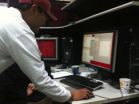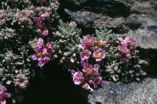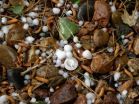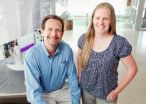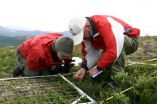Uninsured receive same quantity, value of imaging services as insured in hospital, in-patient setting
2012-01-09
(Press-News.org) Insurance status doesn't affect the quantity (or value) of imaging services received by patients in a hospital, in-patient setting, according to a study in the January issue of the Journal of the American College of Radiology.
Approximately 51 million Americans, or 16.7 percent of the population, were without health insurance for some or all of 2009. Lack of insurance is associated with less preventive care, delays in diagnosis and unnecessary deaths.
"Americans without health insurance generally receive fewer health care services than those with insurance. Less studied are the specific types of services for which the uninsured face access and utilization differences," said Kimberly E. Applegate, MD, MS, lead author of the study.
The primary data source for the study was the 2003 National Hospital Discharge Survey. The principal source of payment was used to define insurance status.
Study results showed that just over nine percent of inpatients were uninsured. And after controlling for measurable factors, uninsured hospital in-patients who underwent imaging received the same number of imaging services of the same value as those for comparable insured persons. The uninsured received fewer interventional and image-guided procedures but more computed tomography (CT) studies that insured patients.
"The number of imaging procedures is similar for insured and uninsured in-patients, as is the procedure intensity," said Applegate.
"Because insurance status does not seem to significantly influence the quantity or value of imaging services received by hospital in-patients, efforts to assist uninsured patients with imaging needs would be better directed elsewhere than the hospital in-patient setting," she said.
INFORMATION:
For more information about JACR, visit www.jacr.org.
To receive an electronic copy of an article appearing in the JACR, or to set up an interview with a JACR author, please contact Heather Curry at 703-390-9822 or PR@acr.org.
END
ELSE PRESS RELEASES FROM THIS DATE:
2012-01-09
An article in the forthcoming issue of the Journal of Integrated Pest Management (JIPM) refutes claims by Greenpeace Germany that the western bean cutworm (WBC), Striacosta albicosta (Smith), is "a new plant pest" that was "caused by genetically engineered corn." The Greenpeace Germany report, which was written by author Christoph Then of Testbiotech, offers a "surprisingly simplistic conclusion" regarding the spread of western bean cutworm over the last decade, according to the JIPM authors.
In "Genetically Engineered Bt Corn and Range Expansion of the Western Bean Cutworm ...
2012-01-09
A biology lab at Washington University has just cracked the structure and function of a protein that plays a key role in the life of a parasite that killed 655,000 people in 2010.
The protein is an enzyme that Plasmodium falciparum, the protozoan that causes the most lethal form of malaria, uses to make cell membrane.
The protozoan cannot survive without this enzyme, but even though the enzyme has many lookalikes in other organisms, people do not make it. Together these characteristics make the enzyme an ideal target for new antimalarial drugs.
The research was published ...
2012-01-09
Climate change is having a more profound effect on alpine vegetation than at first anticipated, according to a study carried out by an international group of researchers and published in Nature Climate Change. The first ever pan-European study of changing mountain vegetation has found that some alpine meadows could disappear within the next few decades.
Led by researchers from the Austrian Academy of Sciences and the University of Vienna, biologists from 13 different countries in Europe analysed 867 vegetation samples from 60 different summits sited in all major European ...
2012-01-09
We've all seen the story in the news before. Whether it's the death of a physically fit high school athlete at football training camp in August, or of an elderly woman gardening in the middle of the day in July, heat stroke is a serious, life-threatening condition for which there is no treatment beyond submersion in ice water or the application of ice packs to cool the body to a normal temperature.
But, in a new study published today in the journal Nature Medicine, scientists discovered what they believe is one of the first drugs to combat heat stroke. AICAR – an experimental ...
2012-01-09
Summertime hail could all but disappear from the eastern flank of Colorado's Rocky Mountains by 2070, according to a new modeling study by scientists from NOAA and several other institutions.
Less hail damage could be good news for gardeners and farmers, said Kelly Mahoney, Ph.D., lead author of the study and a postdoctoral scientist at NOAA's Earth System Research Laboratory in Boulder, Colo. But a shift from hail to rain can also mean more runoff, which could raise the risk of flash floods, she said.
"In this region of elevated terrain, hail may lessen the risk of ...
2012-01-09
A team of scientists, led by researchers at the University of California, San Diego School of Medicine and Zacharon Pharmaceuticals, have developed a simple, reliable test for identifying biomarkers for mucopolysaccharidoses (MPS), a group of inherited metabolic disorders that are currently diagnosed in patients only after symptoms have become serious and the damage possibly irreversible.
The findings will be published online January 8 in the journal Nature Chemical Biology.
MPS is caused by the absence or malfunctioning of a lysosomal enzyme required to break down ...
2012-01-09
Much of what living cells do is carried out by "molecular machines" – physical complexes of specialized proteins working together to carry out some biological function. How the minute steps of evolution produced these constructions has long puzzled scientists, and provided a favorite target for creationists.
In a study published early online on Sunday, January 8, in Nature, a team of scientists from the University of Chicago and the University of Oregon demonstrate how just a few small, high-probability mutations increased the complexity of a molecular machine more than ...
2012-01-09
CHAMPAIGN, Ill. — Those making land use decisions to reduce the harmful effects of climate change have focused almost exclusively on greenhouse gases – analyzing, for example, how much carbon dioxide is released when a forest is cleared to grow crops. A new study in Nature Climate Change aims to present a more complete picture – to incorporate other characteristics of ecosystems that also influence climate.
"We know that forests store a lot of carbon and clearing a forest releases carbon dioxide into the atmosphere and contributes to climate change," said University of ...
2012-01-09
In a report published in Nature Physics, they used graphene, the world's thinnest and strongest material, and made it magnetic.
Graphene is a sheet of carbon atoms arranged in a chicken wire structure. In its pristine state, it exhibits no signs of the conventional magnetism usually associated with such materials as iron or nickel.
Demonstrating its remarkable properties won Manchester researchers the Nobel Prize in Physics in 2010.
This latest research led by Dr Irina Grigorieva and Professor Sir Andre Geim (one of the Nobel prize recipients) could prove crucial ...
2012-01-09
The decade from 2000 to 2009 was the warmest since global climate has been measured, and while localized studies have shown evidence of changes in mountain plant communities that reflect this warming trend, no study has yet taken a continental-scale view of the situation – until now.
With the publication of "Continent-wide response of mountain vegetation to climate change," scheduled for Advance Online Publication (AOP) in Nature Climate Change on 8 January, researchers from 13 countries report clear and statistically significant evidence of a continent-wide warming effect ...
LAST 30 PRESS RELEASES:
[Press-News.org] Uninsured receive same quantity, value of imaging services as insured in hospital, in-patient setting
